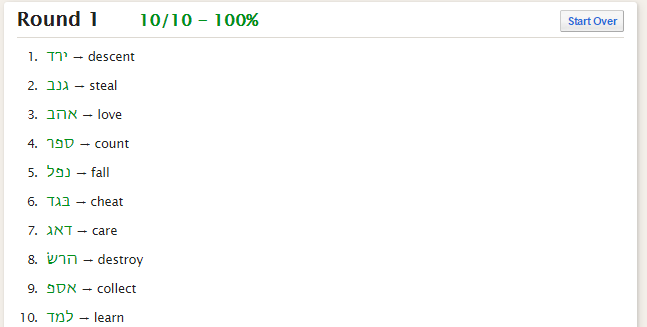I’m the saddest town in town! Ok, that was a really lame Young Frankenstein reference, I’m sorry. I’m not a town, I’m a person. Anyways, the musical is over. This means more time to learn Hebrew, but it also means more time to feel depressed that the musical is over. I have no motivation to do anything except pretend I’m in another world, either by watching Downton Abbey or reading a Rainbow Rowell novel. When I’m not doing one of those two things, the depression washes over me deeply (sorry but I’m going to be making these references for the rest of the post...or the week...or forever).
Anyways, this week definitely had its ups and downs. It started off on a good note when, after my free trial on transparent.com expired, I found an extremely helpful blog called “learnhebreweasily.” This blogspot has organized lessons based on relevance and a logical flow of verbs, prepositions, vocabulary, and other Hebrew nuances.
 |
| It took awhile to get 100%! |
One of the most important structural things I learned was the four different verb conjugations, which are as follows: masculine singular, masculine plural, feminine singular, and feminine plural. As far as I know, there are no irregular verbs, and every verb is conjugated with the same vowel order. Easy right?! Well...it turns out that I’m not as good at remembering Hebrew verbs than I am at remembering French ones. I tried to learn ten this week, but I kept jumbling them all up. To help, I created a Quizlet that I practice whenever I get the chance. This has definitely allowed to me to begin building sentences, for example: אני לומד (Ah-nee loh-med - I learn). If you are interested in seeing the conjugations, take a look at the picture for Lesson 1 below. (Keep in mind that the “X” means a consonant sound, and that the three consonants make up the root of the verb. Every conjugation uses those three letters, in the case of the verb, “learn,” the three letters are למד, or “lamed, mem, dalit.” I’m sorry if this is really confusing, that’s why I wrote it down!
Another useful thing I learned is prepositions. Since each preposition is only one letter, it is connected to the next word. For example, the Hebrew word for “garden” is גן, or “gahn.” If we were to say “the garden,” you would simply add the letter “hay - ה,” which means “the.” Therefore, “the garden” is הגן - ha-gahn.
I also learned pronouns, some of which are interrogative: he - הוא (hoo); she - היא (hee); why - לָמָה (lah-mah); and what - מה (mah). ?למה אני אוהב עברית - Why (do) I love Hebrew?
 |
| Biblical Hebrew doesn't have present tense! |
To help me remember key concepts, I wrote down everything that I thought might be useful. The pictures above are of the first three units, which I immersed myself in this week.
All of this meant that, when my Hebrew book came, I wouldn’t have much use for it...which was a relief. It turns out that the textbook I ordered is a guide to Biblical Hebrew, not Conversational Hebrew. I immediately spoke to my Rabbi, who said that learning Biblical Hebrew would help me a great deal when learning Conversational, so...I will be studying Biblical Hebrew as a little side project; this is the last time you will hear about it on the blog. My Rabbi and I have a scheduled study session on sunday, so my next post will likely be a reflection of that.
Thank you so much (תודה רבה) for reading my blog, and I hope you have enjoyed my journey thus far. I know I have!
שלום!
Weekly Comments:



No comments:
Post a Comment